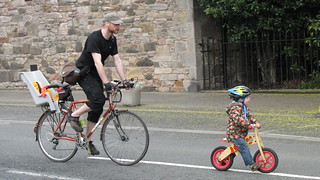They measured overtakes on cyclists wearing 6 diff outfits - varying levels of hi is etc
No diff in how close they were except one with 'police' on it.
CityCyclingEdinburgh was launched on the 27th of October 2009 as "an experiment".
IT’S TRUE!
CCE is 16years old!
Well done to ALL posters
It soon became useful and entertaining. There are regular posters, people who add useful info occasionally and plenty more who drop by to watch. That's fine. If you want to add news/comments it's easy to register and become a member.
RULES No personal insults. No swearing.

They measured overtakes on cyclists wearing 6 diff outfits - varying levels of hi is etc
No diff in how close they were except one with 'police' on it.
'Police; this journey is being recorded on video' more like.
Still the message is that motorists are going to close pass unless "infrastructural, educational or legal measures" are taken to control their behaviour.
It looks as if all of the outfits tested involved some kind of special cycling addition to normal clothes, mostly in the form of extra vests. So it doesn't test whether drivers behave differently with "normal" or "cycling" clothes. But it's interesting nevertheless to see that someone's looking at this sort of thing. Thanks.
(If the roads were laid out safely we wouldn't need to give a hoot about what clothes people wore.)
It looks as if all of the outfits tested involved some kind of special cycling addition to normal clothes
I think one of the outfits consisted of 'normal' clothing.
1% of passes within 50cm!!!
This is (probably) his first bike study -
http://www.bikebiz.com/news/read/want-to-be-bike-safe-don-a-wig-not-a-lid
Yes, interesting that his new one appears to contradict the 2006 study: or maybe not. He's basically saying if all else is equal, and we change one variable (clothing, rather than helmet/no helmet) it makes little difference to drivers' behaviour.
Not his first study in 2006, however. From the article: "Earlier this year, Dr Ian Walker published research that said White Van drivers passed closer to cyclists than car drivers. The University of Bath academic has now used the same video and distance sensor technology to measure drivers' attitudes to women cyclists and cyclists wearing helmets."
I think one of the outfits consisted of 'normal' clothing.
So it did, pardon me
He has a discussing on whether wear Hi-viz makes any significant difference on driver behaviour and concludes that it doesn't.
Is he allowed to use Police?
I thought the fake ones said Polite.
OTOH I've long wondered how TV shows get to drive around in "Police" cars. I saw Taggart being shot once and the panda cars were on a transporter.
I was that close to Ron Mael.
Ron Mael, from Sparks was in Taggart? I missed that.
All the horsewomen and the horseman of Balerno wear yellow hi viz and POLITE bibs. You definitely do a double take even when you know it is fake, well I do as I have been in the presence of policemen and policewomen on horses at demos and football matches.
For POLITE to work on a bike you would need to look like the polis bikers not just the bib?
With stats it is of course possible to find results you are seeking if your sample is big enough.
I have a retroreflective headband in Sillitoe Tartan. I've often wondered if it might be confused (in my favour)for a police helmet.
The threads on POLITE bibs on police forums are roughly the same as helmet threads on bike forums. I wasn't sure of the legality of said bibs, and did some googling. The debates fair brightened my morning.
The study shows that the Policewitness high viz vest significantly increased passing distances.
That's a statistician's "significantly", the average distance was increased by 4-8cm (to 122cm). That difference, although statistically significant, is less than the deviation in travel required to avoid a typical pothole.
So there's nothing found in the study to practically (as opposed to statistically) increase passing distances.
Hi-viz might make you more visible but doesn't make the driver any more courteous.
Worse still, the second driver overtaking, following the first driver, gets closer (by an inch or so)...
Robert
Reading the road cc account, I found this alarming:
"Researchers from the University of Bath and Brunel University found that no matter what clothing a cyclist wears, around 1-2% of drivers will pass dangerously close when overtaking. They also found that compared to Transport Research Laboratory findings in 1979, drivers today on average pass 61cm (2ft) closer to cyclists - 118cm compared to 179cm."
I haven't read the paper to see how comparable the studies are but, if the comparison is valid, this is a damning indictment on driving standards.
TWO FEET!
Yes it certainly is. Depressing.
Is it possible to read it without paying $41.95?
It would be interesting to see how the bike is placed in the road and how much room there is for overtaking, if that's recorded.
There's a prepub at
No diff in how close they were except one with 'police' on it.
Which tells us that drivers are willing to do things to cyclists they wouldn't dare do to a police cyclist.
Which suggests most drivers know their driving is dangerous and intimidating.
A pretty accurate reflection of the state of driving in the UK.
I recommend the link immediately above for the full skinny.
It's interesting that drivers gave most space to the POLICEwitness.com video vest, but *least* to the POLITE vest.
For a hundred eurobucks it's tempting to put together a CCE sensor, although my commute is now pretty poorly suited to collecting data.
It's interesting that drivers gave most space to the POLICEwitness.com video vest, but *least* to the POLITE vest.
Riders also reported subjectively feeling less safe and getting more radge behaviour from drivers in the POLITE vest. Fits with my own observation that some drivers are willing to use their vehicles to punish cyclists who are wearing an outfit they disapprove of. Of course what some people may disapprove of will be different to others..
Dave, I'd considered building one too but my current commute is largely trouble free*
*looks manically for some wood to touch**...
**Quiet at the back.
"Which suggests most drivers know their driving is dangerous and intimidating. "
Or that they are ultra-cautious around police officers. Or both. When you see people too timid to overtake a police car travelling at 10mph under the limit, you suspect ultra-caution.
I recall a few times when an aggressive, engine-revving, close-passing driver suddenly and miraculously turns into a sedate and gentle creature upon sight of a police car or officer. Amazing.
As far as anecdotes go I do feel I get less room when on the road bike (jersey, lycra, helmet) than when cruising on the town hybrid (bare head, casual clothes). Emphasis on 'less' as opposed to none - there's always going to be someone who's going to close pass no matter what.
In fact, thinking about this....someone who close passes everyone on a bike is at least consistent and is most likely to be an inconsiderate driver all round rather than specifically singling out bikes. But people who will close pass some bikes over others, while being an otherwise reasonable driver, that's worrying as they've clearly got some mental process going on to determine who is worthy of respect on the road or not.
Yes, punishment passes... what exactly is going on the the mind of someone who uses their car to try to intimidate another road user, regardless of what they have done?
"they've clearly got some mental process going on to determine who is worthy of respect on the road or not"
Perhaps, but it think part of the rationale - and I think the conclusion of the original study - is the 'assumption' that people on bikes 'with all the gear' are likely to be more experienced, less likely to wobble, able to bunnyhop tram tracks -
or something.
Fair bit of going beyond the data in some of Ian walker's studies, but only really in the conclusions
He can produce more robust findings e.g. Man in long blond wig gets given wider berth than others. Person cycling with POLICE/ POLITE gets wider berth
It is more complicated when you get to the bit where you then have a rationale linked to people wearing kit who get a narrower berth and why this might be?
The blonde wig man and the POLICE/POLITE data remain compelling ie motorists can differentiate if the visual cue is strong enough e.g. Long blonde wig man or POLICE/POLITE notice but do not differentiate with more subtle or distributed cues such as hi-viz kit?
Amir - thanks for posting link for more details.
Gembo the "Police" version had the widest berth, the "Polite" version had the narrowest. The difference in the gear was more than just one letter (T or C), so it wasn't (just?) that drivers could see that one letter different and change the passing distance as a result. The "Police" version had blue printing (more like real police?) but the "Polite" version had black printing. If drivers were able to read the messages they might have seen that these were different too "POLICEwitness.com – move over
– camera cyclist" or "POLITE notice – please slow down".
As Roibeard says "That's a statistician's "significantly", the average distance was increased by 4-8cm (to 122cm)" Maybe we need to know why some drivers passed so much closer than the average, so there is more research needed into other factors?
The rider is passed roughly 100 times on each journey which suggests to me these are pretty busy roads. The rider is recording passes when they are between 0.5 and 0.8m from the kerb, which gives them latitude of 30cm.
The roads are busy so the drivers will often be passing against oncoming traffic - their scope for extending the gap is heavily constrained by the need to avoid smashing into an oncoming car.
We don't know how often cars don't pass but we do know that with a rider latitude of 30cm, we're going to comment on variation in the mean passing distance of +/-4cm and think of that as a function of the rider's clothing and not their distance from the kerb.
I can't be bothered to read the paper at the moment - too much like my job. But what Instography points out may undermine the comparison between years that roadCC picked up on. If the study hasn't been done in a similar way to the previous study, taking a similar cross-section of roads, then there will be confounding.
You must log in to post.

 Cycling in Edinburgh Flickr group
Cycling in Edinburgh Flickr group
Video embedded using Easy Video Embed plugin